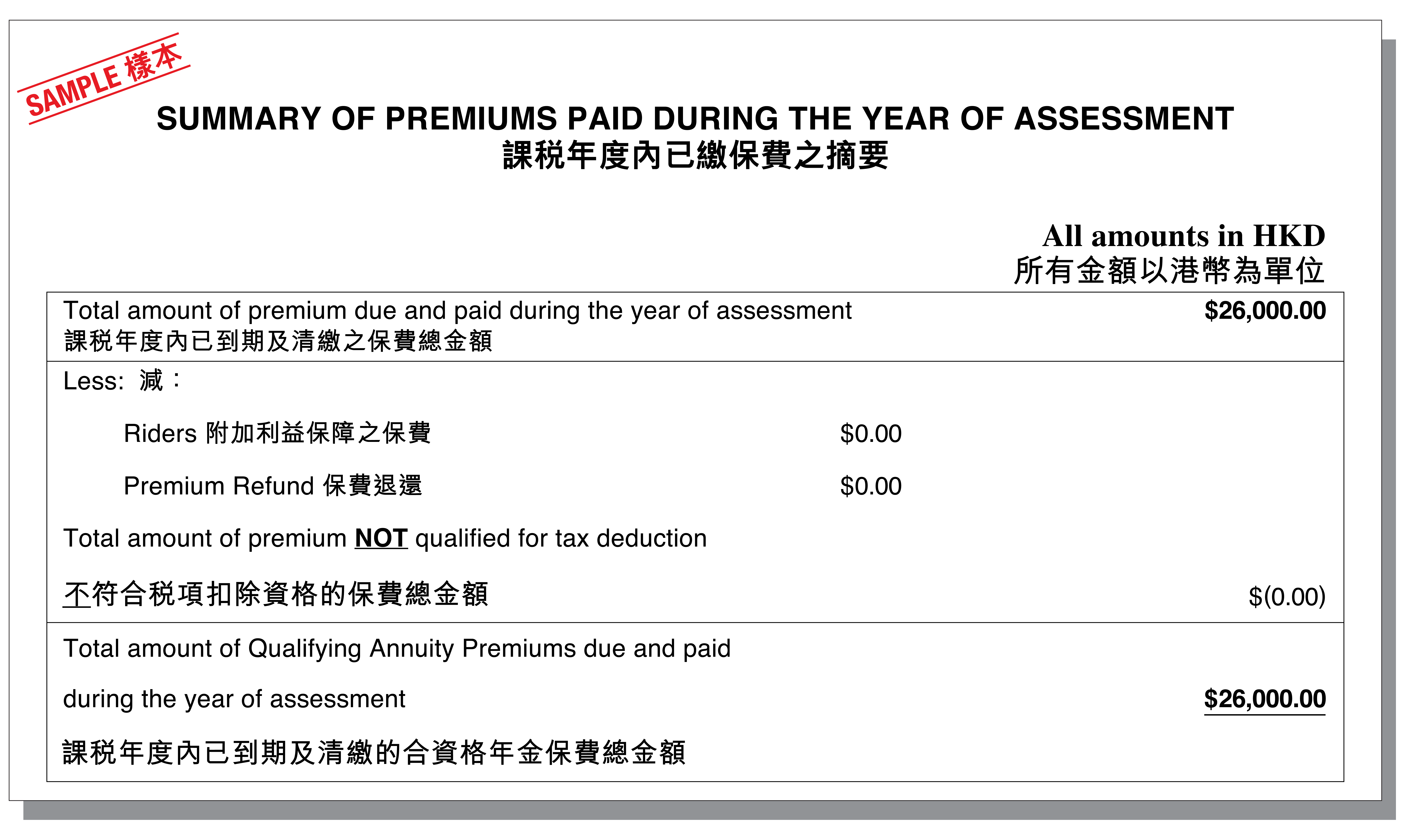QDAP Tax Deduction Tutorial - now in session!
It’s the time of year to file your tax return! If you’re a taxpayer, have you purchased a Qualifying Deferred Annuity Plan (QDAP) during 2020-2021 to save for your retirement and enjoy the tax benefits? If you have, don’t forget to declare your QDAP contributions on your tax return form!

Have all the documents at hand1
Before filling in your tax return form, make sure you have with you the relevant proof of QDAP premiums for the year from your insurance company or its copy, such as an annual summary of QDAP premiums as shown below.

Filling in the tax return form
Part 10 - Qualifying Deferred Annuity Premiums and Tax-deductible Voluntary Contributions (TVC). Item 2a of Part 10 is for the amount of the QDAP premiums that has been paid for yourself, while 2b is for the QDAP premiums paid for your spouse.

If you have paid QDAP premiums for yourself and/or your spouse, fill in the amount(s) in this part. There is no limit to the number of policies eligible for tax deduction, and each taxpayer is entitled to a maximum deduction amount of HKD60,000. A husband and wife who are both taxpayers can allocate their paid QDAP premiums among themselves in order to claim the maximum tax-deductible amount of HKD120,000, but the same amount cannot be claimed twice. As long as the two policies cover the husband or the wife or both of them as annuitants, and the deduction claimed by each of them does not exceed the individual limit of HKD60,000, the couple can claim a total of HKD120,0002 in tax deduction. Keep in mind, though, that HKD60,000 is the aggregate tax-deductible amount for both QDAP premiums and TVC contributions.
Individuals (with more than one QDAP policies)3
Peter has bought two QDAP policies for himself, with annual premiums of HKD50,000 and HKD20,000 respectively. The combined tax-deductible amount from his two policies is thus HKD70,000, exceeding the limit of HKD60,000 per person. Even if he fills in HKD70,000 in Part 10 2a, he will still only be eligible for a maximum of HKD60,000 in tax deduction.
Couples2 (two taxpayers)
Joseph and his wife are both taxpayers and have bought two QDAP policies for themselves. The annual premium Joseph is paying is HKD90,000 while his wife pays HKD30,000 a year. Joseph can apply for tax deduction on HKD60,000 of the HKD90,000 premium he pays. As the wife has not yet used up the deduction limit after claiming deduction for her HKD30,000 premium, she can also claim the HKD30,000 remaining from her husband’s premium. That way, both of them can apply for HKD60,000 in tax deduction, for a combined total of HKD120,000.
Couples2 (with a single taxpayer)
Andrew is a taxpayer. He’s bought two QDAP policies, one for himself and one for his wife, each with an annual premium of HKD60,000. Since his wife is not working and therefore does not have a taxable income, she is not eligible for any tax exemption for her QDAP premiums. The couple can’t file for a joint tax assessment, nor can they each file an individual tax return. That is why Andrew, as the sole taxpayer, is entitled to the individual limit of HKD60,000 in tax deduction and not the combined maximum of HKD120,000.
Tax deduction on both QDAP premiums and TVC contributions4
Jamie is paying HKD50,000 in QDAP premiums and HKD20,000 in TVC contributions each year. Since TVC contributions will be firstly allowed in the order of deduction, she is entitled to a tax-deductible amount of HKD20,000, and the remaining HKD40,000 will be allowed for deduction from her QDAP premiums. The maximum deduction Jamie can claim is thus HKD60,000.
Keep your important documents
Though you don’t have to include your annual QDAP summary with your completed tax return form, you should keep it for 6 years for possible selected reviews by the Inland Revenue Department.
The government introduced a trio of tax-saving schemes. In addition to the tax-deductible QDAP and TVC, a certified VHIS policy will also entitle you to tax benefits. If you haven’t bought any of these, maybe it’s time to start planning for the future and make full use of the tax concessions available.
Source:
- https://www.gov.hk/en/residents/taxes/salaries/allowances/deductions/annuity.htm
- Tax Deductions – FAQs regarding QDAP premiums and MPF VC contributions https://www.ifec.org.hk/web/common/pdf/qdap-tvc/FAQ_eng.pdf
- Number of Qualifying Deferred Annuity Policies https://www.ird.gov.hk/eng/faq/annuity_qp.htm
- Deduction order for qualifying annuity premiums and TVC contributions https://www.ird.gov.hk/eng/faq/annuity_qp.htm
